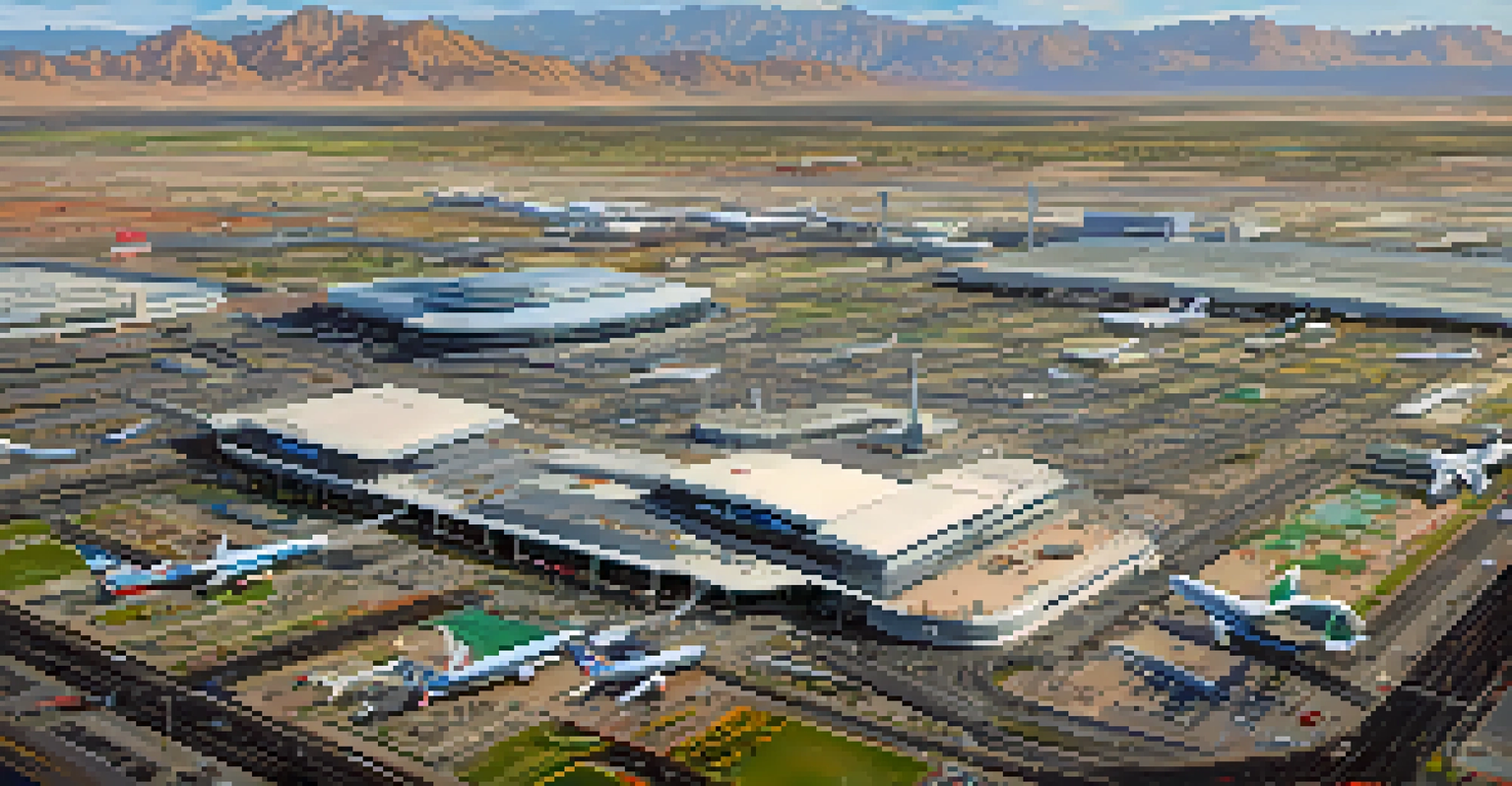The Impact of Tourism on Nevada's Transportation Infrastructure

Tourism as a Key Driver of Transportation Needs in Nevada
Tourism plays a pivotal role in driving the demand for transportation in Nevada. With attractions like Las Vegas and Lake Tahoe drawing millions of visitors each year, the state’s infrastructure faces immense pressure. This influx of tourists necessitates a robust transportation system to accommodate their travel needs.
Tourism is a vital part of our economy, but it must be balanced with sustainable practices to protect our natural landscapes for future generations.
As visitor numbers continue to rise, the need for efficient public and private transport options becomes even more critical. For instance, the Las Vegas Strip relies heavily on taxis, rideshares, and shuttles to move tourists between hotels and attractions. This creates a unique challenge for transit planners to ensure accessibility and convenience for all visitors.
Moreover, the seasonal nature of tourism can lead to fluctuating demands on transportation infrastructure. During peak seasons, roads and public transport systems may become congested, prompting discussions on how to enhance capacity and improve the overall travel experience.
The Strain on Road Networks Due to Increased Tourist Traffic
As tourism surges, Nevada's road networks often find themselves under significant strain. High volumes of vehicles, especially during holidays and major events, can lead to traffic congestion and longer travel times. This issue is particularly noticeable in popular tourist areas where road capacity is frequently exceeded.

For example, the roads leading to attractions like Red Rock Canyon or the Hoover Dam can become bottlenecked with both tourist and local traffic. This congestion can frustrate visitors and locals alike, impacting the overall experience of exploring Nevada’s stunning landscapes. Additionally, increased wear and tear on the roads can lead to higher maintenance costs for the state.
Tourism Drives Transport Demand
The influx of tourists in Nevada necessitates a robust transportation system to meet their travel needs.
To combat these issues, Nevada has invested in expanding and upgrading its road infrastructure. This includes improving access routes to key destinations and implementing smart traffic management systems to optimize flow and reduce delays.
Public Transportation: Meeting the Needs of Tourists
Public transportation in Nevada plays a crucial role in facilitating tourist travel. In cities like Las Vegas, the Regional Transportation Commission operates buses and the monorail, providing essential services for visitors. These options not only reduce the number of vehicles on the road but also offer an affordable way for tourists to navigate the area.
Innovative transportation solutions are essential for enhancing the visitor experience and reducing congestion in our growing tourist destinations.
However, the current public transit system faces challenges in terms of coverage and frequency. Many tourists may find it inconvenient to rely solely on public transport, especially for reaching destinations outside urban centers. Enhancing these services could significantly improve tourist satisfaction and accessibility to attractions off the beaten path.
Furthermore, integrating tourism-focused transit options, such as shuttle services to popular destinations, could alleviate some of the pressure on road networks. This approach would help ensure that visitors can enjoy their experiences without the stress of traffic or parking.
Air Travel: A Gateway for Tourists to Nevada
Air travel is a major component of Nevada's tourism infrastructure, with Las Vegas McCarran International Airport being one of the busiest airports in the United States. The airport serves as a primary gateway for millions of tourists each year, connecting them to various destinations across the globe. As such, investments in airport facilities and services are vital to accommodate this influx.
The rise in low-cost airlines has also made Nevada more accessible to a wider audience, boosting tourism even further. However, this increase in air traffic brings its own set of challenges, including longer wait times and the need for efficient ground transportation options to and from the airport.
Public Transport Needs Improvement
Enhancing public transit services is crucial for improving tourist satisfaction and accessibility to attractions.
To address these challenges, airport authorities are continually enhancing facilities and exploring new transportation links, such as express shuttles and ride-sharing options. These improvements aim to streamline the travel experience for tourists and ensure they can easily transition from air travel to exploring all that Nevada has to offer.
The Role of Innovative Technologies in Transportation
Innovative technologies are increasingly shaping the transportation landscape in Nevada, particularly in response to tourism demands. For instance, smart traffic management systems use real-time data to optimize traffic flow and reduce congestion during busy periods. These technologies help create a more efficient travel experience for both tourists and locals.
Moreover, the rise of ride-sharing services like Uber and Lyft has transformed how tourists navigate cities. These platforms provide an easy and convenient way for visitors to get around, often filling gaps left by traditional public transport. With just a few taps on a smartphone, tourists can request a ride to their desired destination.
Additionally, Nevada is exploring autonomous vehicle technology as a potential solution for improving transportation efficiency. Self-driving shuttles could offer a unique way to transport tourists around popular areas, enhancing accessibility while reducing traffic congestion.
Sustainability in Transportation: A Growing Concern
As tourism continues to impact Nevada's transportation infrastructure, sustainability has become a pressing concern. The increased vehicle emissions and energy consumption associated with higher tourist traffic contribute to environmental degradation. Consequently, there is a growing call for greener transportation solutions that minimize the carbon footprint of tourism.
One effective approach is promoting the use of public transit and non-motorized transport options, such as biking and walking. By encouraging tourists to choose these alternatives, Nevada can reduce traffic congestion while also providing a more enjoyable experience for visitors exploring the state's natural beauty.
Sustainability is Essential
As tourism impacts transportation, adopting greener solutions is vital to minimize environmental effects.
Additionally, the state is looking into electric vehicle (EV) infrastructure to support the growing trend of eco-conscious travel. By investing in charging stations and promoting EV usage among tourists, Nevada can take significant steps towards creating a sustainable transportation ecosystem.
Future Challenges and Opportunities for Nevada's Transportation
Looking ahead, Nevada’s transportation infrastructure faces several challenges as tourism continues to evolve. The state must balance the need for improved access with the preservation of its natural landscapes and cultural heritage. Ensuring that infrastructure expansion does not compromise these vital elements is crucial for maintaining Nevada’s appeal as a tourist destination.
Opportunities also abound as the state embraces innovations in transportation technology and sustainable practices. By investing in smart infrastructure and promoting eco-friendly travel options, Nevada can position itself as a leader in sustainable tourism. This approach not only benefits the environment but also enhances the overall tourist experience.

Ultimately, collaboration among government agencies, private companies, and local communities will be key in addressing these challenges and seizing opportunities. By working together, Nevada can create a transportation system that supports its tourism industry while maintaining its unique charm and natural beauty.